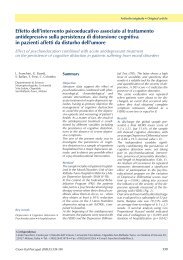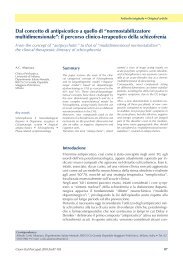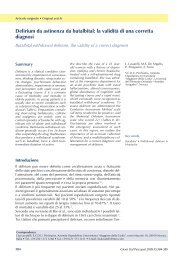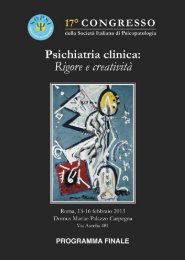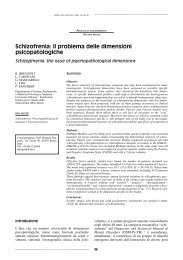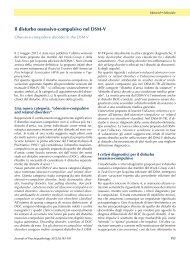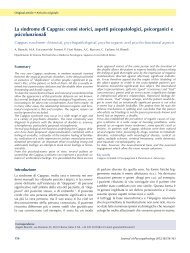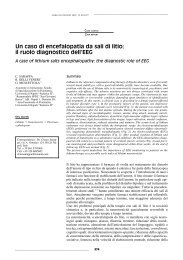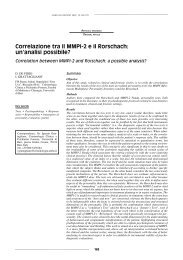XI Congresso della Società Italiana di Psicopatologia Psichiatria ...
XI Congresso della Società Italiana di Psicopatologia Psichiatria ...
XI Congresso della Società Italiana di Psicopatologia Psichiatria ...
Create successful ePaper yourself
Turn your PDF publications into a flip-book with our unique Google optimized e-Paper software.
62. Il riconoscimento delle espressioni<br />
facciali in un campione <strong>di</strong> pazienti<br />
con schizofrenia<br />
G. Cerroni, D. Mirabilio, S. Di Tommaso, M. Aniello,<br />
P. Valente, M. Di Pietro, A. Rossi<br />
Dipartimento <strong>di</strong> Me<strong>di</strong>cina Sperimentale, Università de L’Aquila<br />
Introduzione: l’alterato riconoscimento delle espressioni<br />
facciali (REF) nei pazienti schizofrenici contribuisce ad un<br />
funzionamento sociale deficitario e potrebbe pre<strong>di</strong>re un loro<br />
scarso funzionamento cognitivo (Benoit et al., 2005).<br />
Obiettivo: scopo dello stu<strong>di</strong>o è <strong>di</strong> valutare il REF in una popolazione<br />
<strong>di</strong> pazienti con <strong>di</strong>agnosi <strong>di</strong> schizofrenia.<br />
Metodo: <strong>di</strong>eci pazienti schizofrenici, confrontati con un<br />
gruppo <strong>di</strong> controllo <strong>di</strong> venti soggetti, sono stati valutati con<br />
il test per la <strong>di</strong>scriminazione emotiva <strong>di</strong> Ekman e Friesen<br />
(1976) che presentava 36 foto caratterizzate da 6 emozioni<br />
base <strong>di</strong> felicità, tristezza, paura, rabbia, sorpresa e <strong>di</strong>sgusto.<br />
Inoltre sono stati somministrati il Symptom Check List<br />
(SCL-90), il Millon Clinical Multiaxial Inventory (MCMI-<br />
III) e la Positive and Negative Syndrome Scale (PANSS) per<br />
analizzare la psicopatologia attuale.<br />
Risultati: i pazienti schizofrenici hanno ottenuto un basso<br />
punteggio rispetto al gruppo <strong>di</strong> controllo nel compito <strong>di</strong> riconoscimento<br />
delle espressioni emotive, particolarmente<br />
nella <strong>di</strong>scriminazione <strong>della</strong> paura e del <strong>di</strong>sgusto.<br />
Conclusioni: il nostro stu<strong>di</strong>o conferma che riconoscimento<br />
delle espressioni facciali è alterato nella schizofrenia. In base<br />
ai risultati dei recenti stu<strong>di</strong> che affermano l’esistenza <strong>di</strong><br />
un circuito neurale de<strong>di</strong>cato al riconoscimento dei volti e<br />
delle emozioni espresse me<strong>di</strong>ante la mimica facciale (es. giro<br />
fusiforme e le regioni più anteriori e dorsali del lobo temporale)<br />
si potrebbe quin<strong>di</strong> ipotizzare che nei pazienti schizofrenici<br />
vi è un deficit in tale sistema.<br />
Bibliografia<br />
Benoit B, Krolak- Salmon P, Saoud M, Henaff MA, Burt M, Dalery<br />
J, et al. Facial Expression and Sex Recognition in Schizophrenia<br />
and Depression. Can J Psychiatry 2005;50:525-33.<br />
Ekman P, Friesen WV. Pictures of Facial Affect. Palo Alto, CA:<br />
Consulting Psychologists Press 1976.<br />
63. Amisulpride in Treatment Resistant<br />
Schizoaffective Disorder<br />
C. Cimmino, G. Foggia, I. Celentano, G. Barra, C. Ciliberti,<br />
A. Rocco, T. Cante, M. Romano, E. Mauro<br />
Psychiatry Emergency Hospital “San Giovanni <strong>di</strong> Dio”,<br />
Frattaminore, Napoli<br />
Background: there are not data in the literature regar<strong>di</strong>ng<br />
amisulpride use in resistant schizoaffective <strong>di</strong>sorder.<br />
The objective of this study was to evaluate the efficacy and<br />
safety of amisulpride in treatment Resistant Schizoaffective<br />
Disorder.<br />
This analysis aimed to assess clinical response to amisulpride<br />
treatment in patients with resistant Schizoaffective<br />
Disorder.<br />
Method: a total of 22 patients <strong>di</strong>agnosed with schizoaffective<br />
<strong>di</strong>sorder accor<strong>di</strong>ng to DSM-IV TR criteria and having a<br />
253<br />
POSTER<br />
history of resistance to treatment with other antipsychotics<br />
were included in the study.<br />
The mean amisulpride dose was 600 mg/day and 800<br />
mg/day.<br />
The patients were assessed for Psychotic symptoms with the<br />
Positive and Negative Syndrome Scale (PANSS) at baseline<br />
and at week 12 of amisulpride treatment; for movement <strong>di</strong>sorders<br />
with the Extrapyramidal Symptom Rating Scale<br />
(ESRS); for adverse events (AEs) were reported spontaneously;<br />
for depressive symptoms with HAMD and<br />
MADRS; with Psychiatric Rating Scale (BPRS) and CGI.<br />
Amisulpride was added to other me<strong>di</strong>cations, but other antipsychotics.<br />
Results: there was a significant effect of treatment on improvement<br />
in PANSS total scores from baseline to endpoint.<br />
(69% reduction of positive symptoms in the PANSS positive<br />
subscale and negative symptoms 75% reduction of negative<br />
symptoms in the PANSS negative subscale; p = 0.001).<br />
The reduction in HAMDscores between the baseline (25.6 ±<br />
4.1) and the endpoint (4.2 ± 2.3) was statistically significant<br />
(p = 0.002).<br />
The most commonly observed side effects included asthenia<br />
(6 patients, 26%), weight gain (3 patients, 15%), and mild<br />
sedation (5 patients, 25%).<br />
Marked improvement in CGI after 12 week of treatment<br />
was observed in 22 (100%) patients.<br />
Conclusions: this study suggests that amisulpride may be a<br />
an effective and well tolerated drug for treatment resistant<br />
schizoaffective <strong>di</strong>sorder.<br />
64. Effectiveness and tolerability<br />
of amisulpride in Bipolar Disorder I,<br />
treatment of bipolar mania: results of a 24week<br />
open study<br />
C. Cimmino, G. Foggia, I. Celentano, G. Barra, C. Ciliberti,<br />
A. Rocco, T. Cante, M. Romano, E. Mauro<br />
Psychiatry Emergency Hospital, “San Giovanni <strong>di</strong> Dio”,<br />
Frattaminore, Napoli<br />
Background: amisulpride (Solian), a substituted benzamide<br />
derivative, is a second-generation antipsychotic that<br />
preferentially binds to dopamine D2/D3 receptors in limbic<br />
rather than striatal structures. High dosages preferentially<br />
antagonise postsynaptic D2/D3 receptors, resulting in reduced<br />
dopamine transmission, and low dosages preferentially<br />
block presynaptic D2/D3 receptors, resulting in enhanced<br />
dopamine transmission. Amisulpride has been reported<br />
to be effective in the treatment of schizophrenia and<br />
major depressive <strong>di</strong>sorder.<br />
Method: this was a single-blind clinical trial involving 41<br />
subjects suffering from Bipolar Disorder I, manic phase to a<br />
24-week treatment with Amisulpride (600 mg/day increased<br />
to 800 mg after 7 days of treatment). The sample of 13 females<br />
(F = 31%; mean age 32.4 ± 1.2) and 28 males (M =<br />
69%;mean age 39.1 ± 2.2) consecutively admitted in the<br />
Center for the study of Mood Disorders was recruited in<br />
Emergency Psychiatric Hospital with a DSM-IV TR <strong>di</strong>agnosis<br />
of Bipolar Disorder I, manic phase.<br />
The sample was assessed by Young Mania Rating Scale<br />
(YMRS) total score 20.




